INSTITUT SUPERIEUR D'ANTHROPOLOGIE
INSTITUTE OF ANTHROPOLOGY
ONLINE COURSES / COURS A DISTANCE
INSCRIPTION : Année Universitaire 2012/2013
REGISTRATION : Academic Year 2012 / 2013
GUATEMALA – 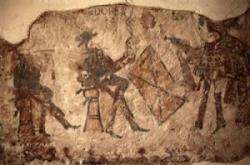 Chajul - In a ramshackle home in Guatemala’s rural highlands, farmer and odd job man Lucas Asicona made for an unlikely guardian of ancient Mayan treasures – until he decided to redo his kitchen. When he pulled back the plaster in his humble colonial-era home of stone, adobe and haphazard wooden boards, he discovered 300-year-old murals, a priceless piece of Guatemalan history. Scenes of tall Europeans beating drums and playing flutes stare out over the one-room dwelling where his family including five children cooked, slept and played. Asicona is among four householders in Chajul, an Ixil Maya community some 220 miles (350 kms) from Guatemala City, struggling to preserve murals revealed after peeling back plaster on the walls of ancient homes. Experts believe similar murals could lie hidden in a further eight homes in the town. Painted by the current occupants’ Mayan ancestors, the friezes cover several walls of the homes, whose colonial history is glimpsed in details including heavy hardwood doors and carved stone pillars propping up modern tin roofs. The murals provide a unique visual record of the moment in history when the local Maya – some depicted in plumed costumes – encountered the tall, bearded conquistadors from Spain who tried to convert them to Christianity. Historians says the murals peeping through the plaster at Asicona’s home illustrate the so-called “conquest dance,” from a time in the 1650s when Spaniards forced locals to build a Catholic Church which still stands at the centre of town. Other paintings in a neighbour’s home show spiralling fireballs that local lore says fell from the sky at the height of the colonial encounter in the 17th century and were thought by the Maya to be a sign of anger from the gods.
Chajul - In a ramshackle home in Guatemala’s rural highlands, farmer and odd job man Lucas Asicona made for an unlikely guardian of ancient Mayan treasures – until he decided to redo his kitchen. When he pulled back the plaster in his humble colonial-era home of stone, adobe and haphazard wooden boards, he discovered 300-year-old murals, a priceless piece of Guatemalan history. Scenes of tall Europeans beating drums and playing flutes stare out over the one-room dwelling where his family including five children cooked, slept and played. Asicona is among four householders in Chajul, an Ixil Maya community some 220 miles (350 kms) from Guatemala City, struggling to preserve murals revealed after peeling back plaster on the walls of ancient homes. Experts believe similar murals could lie hidden in a further eight homes in the town. Painted by the current occupants’ Mayan ancestors, the friezes cover several walls of the homes, whose colonial history is glimpsed in details including heavy hardwood doors and carved stone pillars propping up modern tin roofs. The murals provide a unique visual record of the moment in history when the local Maya – some depicted in plumed costumes – encountered the tall, bearded conquistadors from Spain who tried to convert them to Christianity. Historians says the murals peeping through the plaster at Asicona’s home illustrate the so-called “conquest dance,” from a time in the 1650s when Spaniards forced locals to build a Catholic Church which still stands at the centre of town. Other paintings in a neighbour’s home show spiralling fireballs that local lore says fell from the sky at the height of the colonial encounter in the 17th century and were thought by the Maya to be a sign of anger from the gods.
http://updatednews.ca/2012/10/12/guatemala-farmer-finds-ancient-maya-murals-under-plaster/
USA – 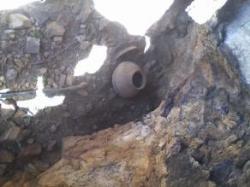
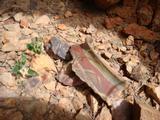 Patagonia Mountains - Sonoita Border Patrol discovered different type of pot last week: agents found two pieces of ancient pottery while patrolling on foot in the Patagonia Mountains. The agents found one intact ancient pot and a piece of another pot while patrolling in the rugged Patagonia Mountains last week, according to a news release form Customs and Border Protection. Agents notified U.S. Forest Service officials, who took the artifacts to a local facility for further study. After initial inspection, the Forest Service believes the pot is genuine, and could date back to as much as 1,000 years.
Patagonia Mountains - Sonoita Border Patrol discovered different type of pot last week: agents found two pieces of ancient pottery while patrolling on foot in the Patagonia Mountains. The agents found one intact ancient pot and a piece of another pot while patrolling in the rugged Patagonia Mountains last week, according to a news release form Customs and Border Protection. Agents notified U.S. Forest Service officials, who took the artifacts to a local facility for further study. After initial inspection, the Forest Service believes the pot is genuine, and could date back to as much as 1,000 years.
http://www.kvoa.com/news/border-patrol-agents-find-ancient-pottery-in-the-patagonia-mountains/
CHYPRE – 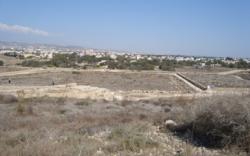 Paphos - In 2012 the second season of excavations of the Department of Classical Archaeology of the Institute of Archaeology of the Jagiellonian University (JU) in Kraków, Poland, took place within the new Paphos Agora Project, which aims at the exploration of the Agora of ancient Paphos, the capital of Cyprus in the Hellenistic and Roman periods. The research took place between August 17th and September 28th. The expedition was led by Professor Ewdoksia Papuci-Władyka, and the team (altogether 29 people) comprised researcher Dr Wojciech Machowski, doctoral students and undergraduate students of the JU Institute of Archaeology, as well as volunteers. The first week of this year’s campaign was devoted to the work on material uncovered in the previous year. Numerous vases, mostly amphorae, were glued, drawings were made and photographs were taken; selected artefacts were elaborated. Fieldwork was conducted during the four weeks from August 27th to September 22nd. The last week was devoted to elaboration of uncovered material and the closing of the season.
Paphos - In 2012 the second season of excavations of the Department of Classical Archaeology of the Institute of Archaeology of the Jagiellonian University (JU) in Kraków, Poland, took place within the new Paphos Agora Project, which aims at the exploration of the Agora of ancient Paphos, the capital of Cyprus in the Hellenistic and Roman periods. The research took place between August 17th and September 28th. The expedition was led by Professor Ewdoksia Papuci-Władyka, and the team (altogether 29 people) comprised researcher Dr Wojciech Machowski, doctoral students and undergraduate students of the JU Institute of Archaeology, as well as volunteers. The first week of this year’s campaign was devoted to the work on material uncovered in the previous year. Numerous vases, mostly amphorae, were glued, drawings were made and photographs were taken; selected artefacts were elaborated. Fieldwork was conducted during the four weeks from August 27th to September 22nd. The last week was devoted to elaboration of uncovered material and the closing of the season.
http://www.moi.gov.cy/moi/pio/pio.nsf/index_en/index_en?opendocument
ROYAUME UNI - Bristol - The redevelopment of Cadbury's chocolate factory in Keynsham has unearthed further evidence of a Roman settlement in the town. Taylor Wimpey, the firm behind the development, has revealed that an archaeological survey has found further evidence of the Roman settlement of Trajectus. There has long been speculation that the lost Roman settlement was in the area and coins and other artefacts have been discovered in the town. Trajectus is the Roman word for bridgehead and the town is thought to have been a crossing point of the nearby River Avon. The small town or settlement is thought to have been built around 155 AD and included at least two Roman villas. By the Middle Ages the settlement had developed into a bustling town complete with an Abbey and a market.
http://www.thisisbristol.co.uk/Roman-ruins-chocolate-factory/story-17064714-detail/story.html
USA – 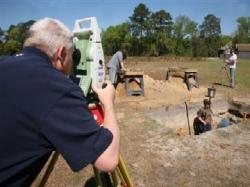 Camp Lawton - Archaeologists have found the remains of the Camp Lawton stockade wall, establishing the actual layout and site of one of the Civil War's largest prisoner of war camps. A significant portion of the southern wall of the camp was exposed along with a section of the western wall which enabled archaeologists to project the exact location of the southwestern corner.
Camp Lawton - Archaeologists have found the remains of the Camp Lawton stockade wall, establishing the actual layout and site of one of the Civil War's largest prisoner of war camps. A significant portion of the southern wall of the camp was exposed along with a section of the western wall which enabled archaeologists to project the exact location of the southwestern corner.
http://www.gpb.org/news/2012/10/11/civil-war-prison-camp-wall-uncovered
ROYAUME UNI –  Colchester - Remains dating back hundreds of years could provide a new insight into Colchester life - Roman style. Experts from the Colchester Archaeological Trust are investigating what lies beneath the surface of the car park in Butt Road, Colchester. And they hope their findings will unlock secrets of life from 2,000 years ago. In Roman times, bodies were buried outside the town wall. Trust director Philip Crummy said thousands of people would have been buried in the land stretching away from Colchester’s fortification. The Trust has carried out numerous excavations as part of the redevelopment of Colchester Garrison and have made a range of discoveries including finding Britain’s only chariot circus.
Colchester - Remains dating back hundreds of years could provide a new insight into Colchester life - Roman style. Experts from the Colchester Archaeological Trust are investigating what lies beneath the surface of the car park in Butt Road, Colchester. And they hope their findings will unlock secrets of life from 2,000 years ago. In Roman times, bodies were buried outside the town wall. Trust director Philip Crummy said thousands of people would have been buried in the land stretching away from Colchester’s fortification. The Trust has carried out numerous excavations as part of the redevelopment of Colchester Garrison and have made a range of discoveries including finding Britain’s only chariot circus.
http://www.gazette-news.co.uk/news/9980229.Excavations_to_find_out_Colchester_life___Roman_style/?ref=mmsp
PEROU – 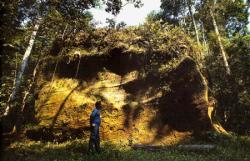 Balsapuerto - The petroglyph, known as the 'sacred boulder of Cumpanama', lying deep in the rainforests of Peru, is being studied by scientists. Located in the District of Balsapuerto, Province of Alto Amazonas, Department of Loreto, it was first discovered in 1997 by geologist Jose Sanchez Izquierdo. Since then it has been examined extensively by archaeologist Santiago Rivas. The petroglyph is approximately 6.2m high, 13.3m long and 8.5m wide. It is surrounded by beautiful ravines and waterfalls. A man belonging to the Shawi ethnic group believes that the petroglyph is a 'guidebook' to dwell in the forests. Santiago Rivas goes on to claim the petroglyph panel may have been created and used for ceremonial purposes and that ancient dwellers manufactured stone tools such as axes at the site: "I think so because of the marks found at the top of the petroglyph panel. Here the men made the 'magic' tools that allowed them to overcome the difficulties in the jungle environment". The petroglyph is very complex and sophisticated in terms of the number of motifs, the design of individual motifs and their interrelation. Whilst the panel has not yet been de-coded, Rivas believes that if the assumptions and estimates are correct, the 'sacrerd boulder of Cumpamama' may represent the cornerstone of the oldest known ceremonial center in the Peruvian Amazon.
Balsapuerto - The petroglyph, known as the 'sacred boulder of Cumpanama', lying deep in the rainforests of Peru, is being studied by scientists. Located in the District of Balsapuerto, Province of Alto Amazonas, Department of Loreto, it was first discovered in 1997 by geologist Jose Sanchez Izquierdo. Since then it has been examined extensively by archaeologist Santiago Rivas. The petroglyph is approximately 6.2m high, 13.3m long and 8.5m wide. It is surrounded by beautiful ravines and waterfalls. A man belonging to the Shawi ethnic group believes that the petroglyph is a 'guidebook' to dwell in the forests. Santiago Rivas goes on to claim the petroglyph panel may have been created and used for ceremonial purposes and that ancient dwellers manufactured stone tools such as axes at the site: "I think so because of the marks found at the top of the petroglyph panel. Here the men made the 'magic' tools that allowed them to overcome the difficulties in the jungle environment". The petroglyph is very complex and sophisticated in terms of the number of motifs, the design of individual motifs and their interrelation. Whilst the panel has not yet been de-coded, Rivas believes that if the assumptions and estimates are correct, the 'sacrerd boulder of Cumpamama' may represent the cornerstone of the oldest known ceremonial center in the Peruvian Amazon.
http://www.bradshawfoundation.com/news/